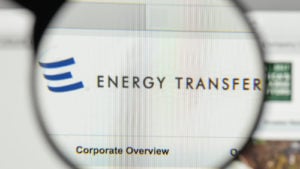Diving into these stocks reveals a tale of operational prowess, financial stability, and market adaptability. Through prudent management decisions, enhanced operational volumes, and aligned strategic planning, these stocks seem poised to deliver dividends and steady, sustainable growth. As the investment landscape fluctuates, these dividend dynamos offer investors a sanctuary of stability and promise for the upcoming year.
Hess Midstream (HESM)

Hess Midstream (NYSE:HESM) focuses on enhancing shareholder value through consistent distribution growth. It is a fundamental strength contributing to its attractiveness as an investment opportunity. For instance, the quarterly announcement of a $0.6175 per Class A share distribution for Q3 2023 signifies a 2.7% increase compared to the previous quarter. This increase comprises a 1.5% rise in distribution levels per Class A share and a consistent quarterly 1.2% increase. This growth is aligned with their target of achieving at least 5% annual growth in distributions per Class A share through 2025.
This consistent distribution growth indicates the company’s financial stability, strong operational performance, and strategic focus on delivering value to shareholders. Hess Midstream expects to maintain over $1 billion of financial flexibility through 2025. It can be used to support its return on capital framework. This reserve allows the company to seize strategic opportunities, invest in growth initiatives, and return value to shareholders through distributions or potential unit repurchases.
Hess Midstream acted towards significant increases in throughput volumes across its operational segments to support distributions. Gas gathering and gas processing increased by 9%; terminaling saw a notable surge of 17%; and water gathering witnessed a substantial increase of 19%.
Fundamentally, these increments were primarily attributed to heightened Hess Midstream drilling activity, improved gas capture, and increased third-party volumes. Thus, the growth in throughput volumes signifies operational efficiency and effective utilization of infrastructure and resources.
Finally, the increased throughput volumes and strong partnerships with Hess Corporation (NYSE:HES) and other third-party entities demonstrate the company’s ability to handle growing demand. Lastly, the growth in operational volumes lays a robust foundation for revenue generation and supports distribution plans.
Energy Transfer (ET)

Energy Transfer (NYSE:ET) has a track record of maintaining and increasing investor distributions. In Q3 2023, the company announced a quarterly cash distribution of $0.3125 per common unit, marking an increase from the previous quarter. Energy Transfer displays a 9.11% forward dividend yield, paying $1.25 annually with a high 116.51% payout ratio.
Notably, the company can generate substantial discounted cash flow (DCF), reaching $1.99 billion for Q3 2023, indicating a healthy cash flow position to sustain and potentially increase distributions. Energy Transfer’s management typically evaluates distributions relative to DCF, ensuring a sustainable payout ratio. Therefore, this disciplined approach helps balance rewarding shareholders and retaining capital for growth initiatives.
The DCF is supported by operational efficiencies such as NGL fractionation, transportation, and exports, achieving new partnership records in NGL fractionation volumes (up 9%), transportation volumes (up 14%), and exports (up more than 20%), highlighting the company’s strong market position and efficient operational management. Also, the substantial growth in these segments indicates robust demand and the ability to handle increased throughput effectively.
Looking at Midstream and Natural Gas Transportation, witnessing the growth in gathered volumes (up 4%), intrastate (up 2%), and interstate natural gas transportation volumes (up 15%) showcases the company’s operational robustness and adaptability in diverse operating regions.
Finally, upgrading Energy Transfer’s senior unsecured debt rating to BBB with a stable outlook by Standard & Poor’s suggests improved creditworthiness and enhanced investor confidence in the company’s financial stability. As a result, this enhanced rating can potentially lead to better access to capital markets and reduced borrowing costs. It may further strengthen the company’s financial position to support distributions.
Northrim BanCorp (NRIM)

Northrim BanCorp (NASDAQ:NRIM) offers an attractive forward dividend yield of 4.82%, providing investors with a decent income stream. The annual payout of $2.40, with the company’s 13-year history of consistent dividend growth, showcases its stability and focus on rewarding shareholders. Also, the payout ratio of 50.21% indicates that Northrim BanCorp is using roughly half of its earnings to pay dividends, suggesting a sustainable payout level.
Looking at the fundamentals supporting distributions, the company experienced significant loan growth, reaching $1.72 billion on September 30, 2023, marking a remarkable 14% increase from December 31, 2022, due to the increased commercial and consumer mortgage loan activities. Fundamentally, the loan surge indicates robust lending operations and potential revenue expansion through interest income.
At the macro level, the real estate market in areas where Northrim Bank operates exhibited consistent growth in average sales prices despite declines in housing unit sales. In Anchorage, the average sales price of a single-family home rose 7.6% in 2022 to $456,544. These trends suggest stability and appreciation in residential property values, supporting the bank’s lending activities.
Finally, Alaska’s forecasted growth in crude oil production is expected to reach 504,000 barrels per day in fiscal year 2024 and further increase to 556,000 barrels per day in 2028. Thus, this indicates positive prospects for the region’s economic development. This growth primarily stems from new online production in the NPR-A region west of Prudhoe Bay, signifying potential opportunities for businesses related to the oil and gas sector.
On the date of publication, Yiannis Zourmpanos did not hold (either directly or indirectly) any positions in the securities mentioned in this article. The opinions expressed in this article are those of the writer, subject to the InvestorPlace.com Publishing Guidelines.
Yiannis Zourmpanos is the founder of Yiazou Capital Research, a stock-market research platform designed to elevate the due diligence process through in-depth business analysis.
